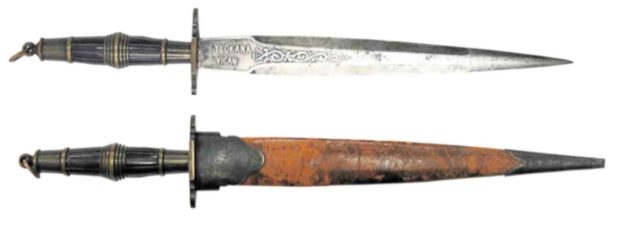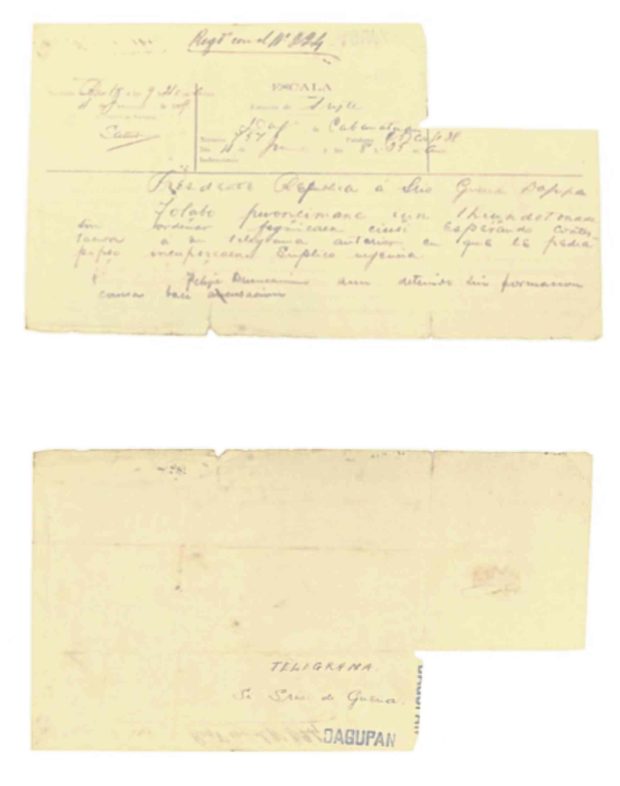
A telegraph dated June 4, 1899, purportedly sent by President Emilio Aguinaldo to Gen. Antonio Luna summoning him to a conference in Cabanatuan, Nueva Ecija, where he would later be killed by Aguinaldo’s own men in one of the most controversial episodes in Philippine history, has surfaced and it will be auctioned off by León Gallery on Dec. 1.
The telegraph appears to be the smoking-gun evidence that historians have been looking for to establish that Aguinaldo himself engineered the assassination of Luna by his own Kawit platoon, said writer and León consultant Lisa Guerrero-Nakpil.
The platoon, whose members were Cavite provincemates of Aguinaldo, had an axe to grind against Luna for dressing them down and even spanking them for lack of discipline.
The telegram is lot 122 of the auction and is titled, “The Extremely Important Heneral Luna Telegram, from Aguinaldo Summoning him to his Death.”
Provenance is the estate of Grace Luna de San Pedro, who married the famous architect Andres Luna de San Pedro (1887-1952), the son of Juan Luna, Antonio’s brother.
The telegram is reportedly one of four sent by Aguinaldo in various points of Luzon to locate Luna.
His aides said Luna had been summoned to Cabanatuan by Aguinaldo for a meeting, but this was denied by Aguinaldo.
In “Malolos: Crisis of the Republic” (1960), historian Teodoro Agoncillo said Aguinaldo could not have been responsible for Luna’s death. “The mystery of Luna’s death hinges on a telegram that he purportedly received from Cabanatuan,” he wrote. “The telegram is missing, and no one has seen a copy.”

Lot 122 is not the Cabanatuan telegram, but it is one sent from Dagupan allegedly by Aguinaldo himself.
Aside from Dagupan, a telegram was sent from San Juan Bautista in Tarlac, which reportedly is in the Felipe Hidalgo collection. Two others—sent from San Fernando, Pampanga, and from Cabanatuan—are missing.
Agoncillo quoted the statement of telegraph operator Teodoro Cada on the authenticity of the Dagupan telegram based on Cada’s letter to the editor of Pagkakaisa newspaper on Oct. 28,1928.
Cada said Aguinaldo approached him wearing only his undershirt and shorts. In the auction catalogue, Guerrero-Nakpil writes that Aguinaldo’s “disheveled” looks probably “reflect(ed) his sleeplessness over a terrible decision.”
According to the catalogue, the telegram in Spanish read, “President of the Republic to the Secretary of War, Dagupan. Paging for an important meeting, therefore, you are ordered to come here immediately… It is really an emergency.”
Luna’s reply
The telegram contains a handwritten reply from Luna to be telegraphed back to Aguinaldo, saying, “Felipe Buencamino not yet detained based on my accusation.”

Luna had famously exploded in a cabinet meeting and slapped Buencamino, Aguinaldo’s foreign secretary, calling him a coward for proposing to negotiate with the Americans.
Arriving in Cabanatuan on June 5, 1899, Luna found Buencamino who told him Aguinaldo had left. The two exchanged heated words and when a shot rang outside, Luna went down and found Kawit officer Pedro Janolino whom he had previously disarmed for insubordination. Janolino swung his bolo at Luna and the other Kawit guards shot him. Luna died with more than 30 wounds.
Including Spanish military paraphernalia captured by Luna and also coming from the Grace Luna de San Pedro estate, the controversial telegram will be auctioned off with a floor price of P500,000.
Luna and his fiery character and devoted patriotism has captured the popular imagination, especially after the 2015 movie, “Heneral Luna.” Directed by Jerrold Tarog, the movie portrays Luna, powerfully played by John Arcilla, as a swashbuckling devil-may-care general who’s intolerant of incompetence and indiscipline of some of Aguinaldo’s other officers, who are portrayed as operating based on clannish, regionalistic and ultimately self-serving interests.

The movie earned at least P200 million in the box-office, and its producers this year released a follow-through, a biopic of Gen. Gregorio del Pilar, Aguinaldo’s favorite general whom the movie depicts as his henchman.
Tejeros, Naik documents
Also to be bidded out are historical documents related to the infamous Tejeros convention of 1897, including the Acta de Naik, in which Andres Bonifacio and 41 others said that the Tejeros meeting was a “betrayal” of the revolution. Both documents (Tejeros and Naik) each has a floor price of P1 million.
Also to be bidded out is the 4×7 feet copy of Juan Luna’s “Spoliarium” made by Antonio Dumlao. Dumlao (1912-1983). restored the “Spoliarium,” when it was repatriated by Spain in 1958.













































